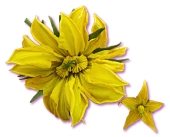Hi (neighbor) Kurt!
I am curious about what experts have to say about it!
My short answer would be YES, I think it would be a good idea to at least not promote cross-pollination the first year. After reading Lofthouse book, Going to Seed course, and thinking about it, I think that a good way to develop a landrace departing from several varieties would be:
- Year 1. IDENTIFY WHICH VARIETIES PERFORM (AT LEAST REASONABLY) WELL IN YOUR GARDEN: Sow several varieties without promoting cross-pollination; for instance, instead of interplanting varieties, placing individuals from the same variety “away” from other varieties (and close within variety) to easily perceive inter-variety differences on how they thrive in your garden. Cull an entire variety as soon as you see it struggling in your garden (growing too slowly, suffering diseases...) (similar to the “sibling group planting” but for varieties). The aim would be to not allow pollen from varieties that do not thrive in your garden to pollinate the varieties that you will want to keep. (As Lofthouse says in p. 33 “It’s easier if I don’t introduce traits that have to be culled later.”. This is said in the context of not mixing sweet and hot peppers, but I think it may also apply here). Finally, keep seeds from survivors and especially from those varieties that best perform in terms of production.
- Year 2. CROSS VARIETIES THAT PERFORM WELL IN YOUR GARDEN: Interplant varieties of seeds from Year 1 to maximize cross-pollination (maybe allowing a second chance to some unsuccessful varieties from Year 1 or new varieties), even doing some “freelance hybrids” to enhance cross-pollination in difficult species. Try to identify hybrids and store the seeds separately to give them priority in Year 3. Again, keep seeds from best-performing individuals (this time the identity of varieties may have started to be less important; keep seeds mixed).
- Year 3, 4, 5.... KEEP DEVELOPING, AND THEN MAINTAINING YOUR LANDRACE: Keep sowing seeds from the previous year (and some few older seeds, and new seeds, hopefully also seeds from similar landraces from neighbors

), giving priority to identified hybrids. Start (liberally) selecting the traits you are searching for. Maybe be a bit cautious when introducing new varieties (maybe placing them a bit apart the first year to see how they perform) before allowing them to blend into the landrace.



 ), giving priority to identified hybrids. Start (liberally) selecting the traits you are searching for. Maybe be a bit cautious when introducing new varieties (maybe placing them a bit apart the first year to see how they perform) before allowing them to blend into the landrace.
), giving priority to identified hybrids. Start (liberally) selecting the traits you are searching for. Maybe be a bit cautious when introducing new varieties (maybe placing them a bit apart the first year to see how they perform) before allowing them to blend into the landrace.